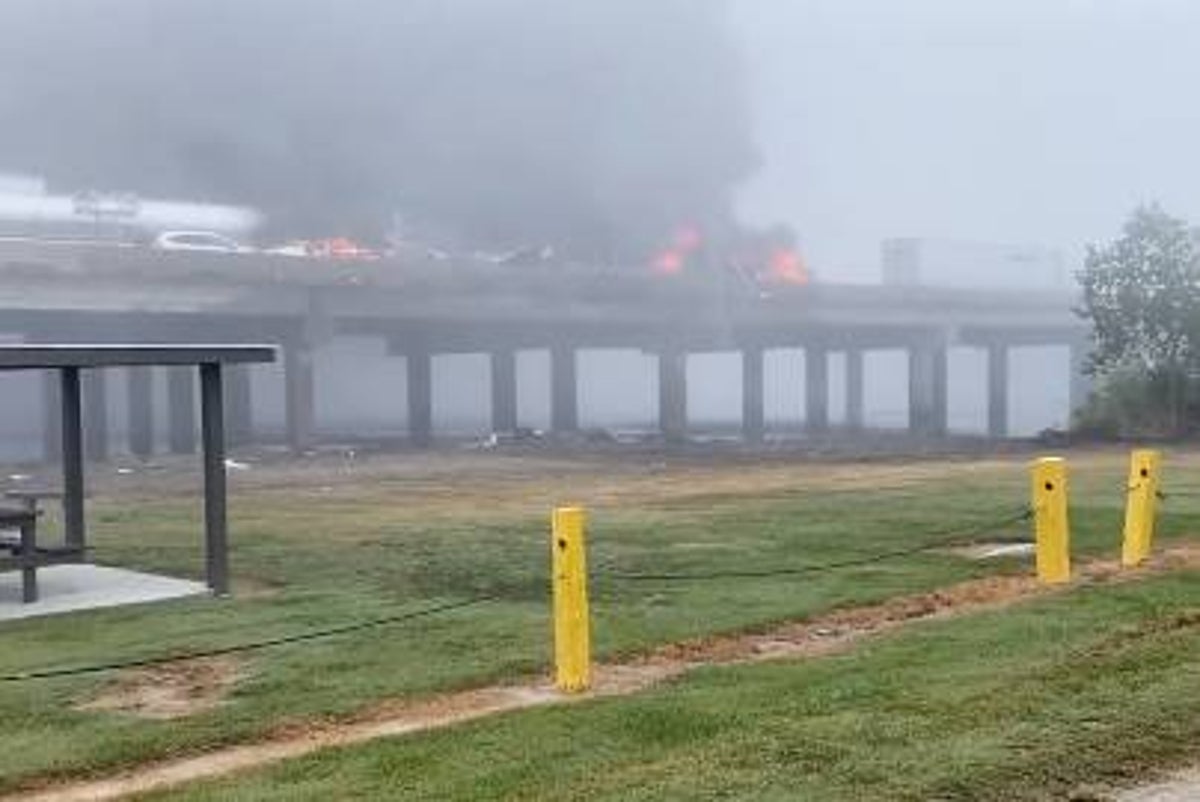
Two separate incidents involving superfog have resulted in fatalaties on New Orleans roads in a matter of weeks.
On Tuesday, local authorities said that the that wildfire smoke from marsh fires mixed with dense fog early in the morning causing near-zero visibility. The thick fog caused multiple accidents and the death of a male motorist.
Last month, a similar event caused a massive multi-car pile-up and dozens of other crashes, killing at least seven drivers and injuring dozens more, also near New Orleans. Major roads were closed and drivers advised to take extreme caution.
The National Weather Service (NSW) in New Orleans says that while incidents of super fog are not unusual, increased levels of drought in the region may have had an impact on their severity.
Here is what you need to know.
A multi-car pile-up caused by super fog in Louisiana— (Copyright 2023 The Associated Press. All rights reserved.)
What is “super fog”?
Super fog is a weather phenomenon caused when smoke and moisture – often released from damp, smoldering organic material such as leaves and brush – mixes with cooler, moisture-laden air.
Particles from the smoke attach to the water molecules, producing a thicker fog.
Super fog, which meanders across low terrain when there are light winds, can lower visibility to less than ten feet and prove very hazardous when present over highways.
Super fog is a technical term and is officially used by meteorologists, describing conditions that are more “enhanced” than typical fog.
Is super fog the same as smog?
Tyler Stanfield, NWS meteorologist in New Orleans, says that super fog is “strictly an organic occurrence” – unlike smog which is caused by man-made pollutants.
Mr Stanfield told The Independent that smog is typically caused by pollutants such as vehicle emissions and industry dust that are not organic.
“Smog you typically see in big, urban areas like LA or New York – places like that where the environment is more favorable for those kinds of things to get trapped in the lower levels – health hazards.” he said. “
“Super fog is more strictly an organic occurrence.”
What happened in New Orleans?
On Tuesday morning a thick superfog in in the Irish Bayou near New Orleans sparked another string of accidents. The conditions caused near-zero visibility for drivers on the I-10, which saw multiple accidents and the death of a male motorist.
New Orleans Police Department said that multiple people were taken to the hospital and sections of I-10 were closed in both directions.
Conditions in the area had cleared up by 11am, according to the National Weather Service, which had warned motorists to stay off the roads.
On Monday October 23, a patch of superfog on the I-55, also near New Orleans caused a massive multi-car pile-up and dozens of other crashes. At least seven motorists were killed and dozens more were injured.
Officials said that around 100 people were stranded on the roadyand that police officers had to run along it to reach the crash site. A 24-mile elevated stretch of highway over Lake Pontchartrain was closed by police.
Visibility had been reduced to 10 feet in some areas.
A crash caused by ‘super fog in Louisiana— (Copyright 2023 The Associated Press. All rights reserved.)
Is super fog common in Louisiana?
Mr Stanfield said the appearance of super fog was “not atypical” in the area during cold seasons and could occur two or three times per year.
“All it takes is a specific environment where we have more smoke and other things in the air that can enhance it,” he told The Independent.
“We actually saw super fog on New Year’s Eve this year due to the fireworks smoke, and that’s not necessarily uncommon for that time of year with the cold weather conditions.”
An exceptional drought in Louisiana has caused drier conditions in recent months, leading to more marsh fires which burn for longer – making the chances of super fog more likely, Mr Stanfield said.
He added that although this week’s batch of super fog could not be directly linked to climate change, increasing global temperatures and their results had “definitely compounded” the issue.
“This is the most intense drought we’ve seen in about a decade,” he said. “We also had a heatwave throughout the summer which fueled that drought.”
“I would say it’s hard to directly link it, [but] you can definitely say that there is influence there. It’s not necessarily strictly any kind of climate change related activity, but as far as what we’ve seen for this time of year… we’ve seen a lot more smoke than we’ve had in several years.”
What do I do if caught in super fog?
Louisiana is currently under “burn bans” in order to reduce the amount of fire smoke in the air, and to minimise the risk of further super fog.
Forecasters warn that anyone driving in foggy conditions should slow down, allow extra time to reach a destination, and ensure the vehicle is visible using low-beam headlights and tail lights.
High-beam headlights should never be used as the light causes glare and makes it more difficult for drivers to see what is ahead of them on the road, according to NWS.
Drivers should also always leave extra distance from the person in front of them and follow the lines of the road with their eyes.
In cases of extremely dense fog, where visibility is near zero, drivers are advised to turn on hazard lights and stop in a safe location. If none are available, drivers are advised to pull off the road, and turn on hazard lights.







